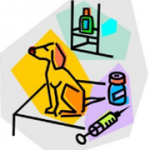The practice of feeding a raw meat-based diet has seen significant growth over the past decade. It is a subject that divides opinion, even in the veterinary industry, with varying arguments from nutritional implications to wider health impacts. The lack of any significant in-depth evidence for or against, continues to fuel the fire of debate. So as a dog owner what do you need to know in order to make a decision based on the best information we currently have?
The advocates of raw food diets argue they provide the best ‘natural’ food source for your dog from an evolutionary perspective. Users have anecdotally claimed that they see an increase in energy, improved digestive systems, shinier coats and a decrease in some allergic skin diseases.
Opponents of the movement however have concerns regarding the nutritional balance, contamination with bacteria, and danger of bone consumption.
So here are some facts that we do know:
Our modern-day domesticated pooches are now genetically a long way from wild wolves in many aspects. This includes diets they have become adapted to. Geneticists in 2013 found that our pets have adapted to starch- rich diets as opposed to protein since being domesticated thousands of years ago.
Raw food diets have been shown to have greater palatability.
Bacteria (E.Coli in 80%, Salmonella in 20%, Campylobacter & Listeria in 43%) have been isolated from a range of commercial raw feed products in a recent study.
Freezing does not kill bacteria.
Undoubtedly a raw food diet is likely to be more palatable than a dry kibble diet. I mean, who can honestly say their dog would prefer a dry biscuit to a juicy, tender morsel of meat? We also just do not know yet whether the other claims made by pro-raw feeders are vindicated. Currently there is no scientific based evidence to back them up. That does not however mean there won’t be in the future.
It is the growing body of evidence regarding potential implications with wider health that seems to make the non-converted uneasy. The bacteria listed above are no joke. Isolation of them on the best commercial raw feed available has to be a worry. This is not just a danger to the pet, but also to their human counterpart who handles the raw meat and picks up the aftermath in the park, in which bacteria are then shed.
The presence of bones in diets is also contentious. Whilst they do a great job of cleaning teeth, they also provide a risk in their journey through the digestive tract.
If you do decide to go raw, it is vitally important that you do your research and make sure the diet is executed properly. Use a commercial diet that tests its product to ensure adequate nutrition is met. Producers that are DEFRA accredited and part of the Pet Food Manufacturers Agency (PFMA) are required to do this in order to meet trading standards. One thing that both sides of the debate can agree on is the difficulty of feeding raw based on home recipes. Studies have found even expert nutritionists don’t always get the balance right! Secondly, be completely aware that you are handling raw meat, whether homemade or commercially sourced, from which multiple bacterial organisms have been isolated. Make sure your hygiene when defrosting, handling, feeding and cleaning is heightened, and you have measures in place to protect both your animal and other members of the household.
Of course, as with any diet, the best of one will be better than the worst of the other. The dog on the best raw food diet will be better off than the dog on the worst non-raw food diet. Most importantly, your dog should be on a specifically formulated diet that is safe and contains all the required nutrients and minerals.
Frustratingly, we cannot yet give you a yes or no answer to the title of this article. Whilst there is enough emerging evidence to suggest raw food diets can be a foe, we certainly cannot rule out their added value as a friend. It is to be seen in the coming years if any evidence base can be produced for the positive claims made by pro-raw feeders, so watch this space!
 Willett House Vets
Willett House Vets
